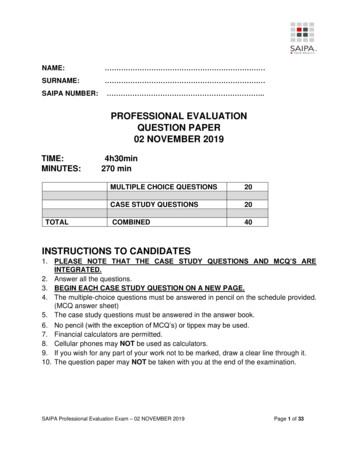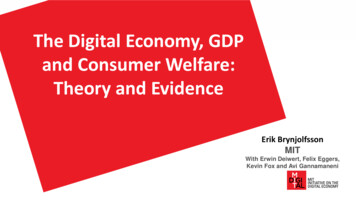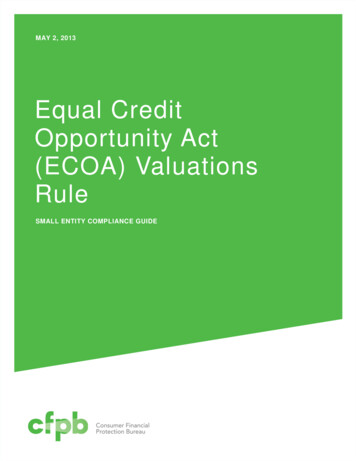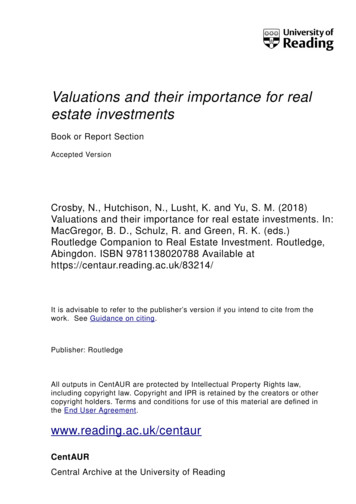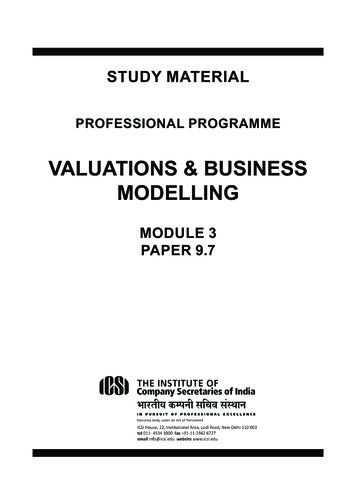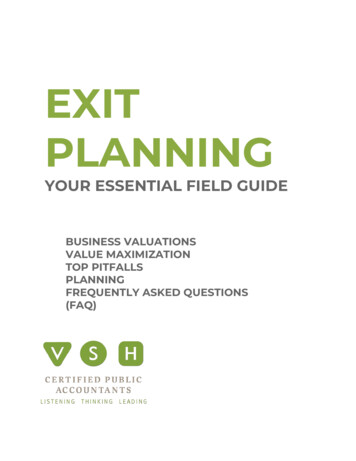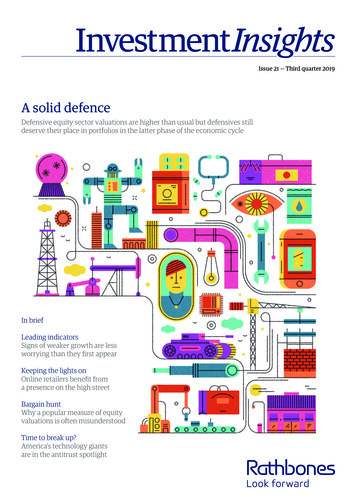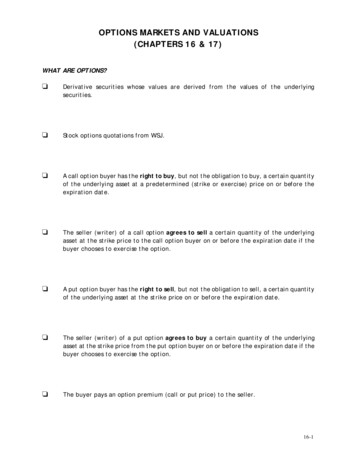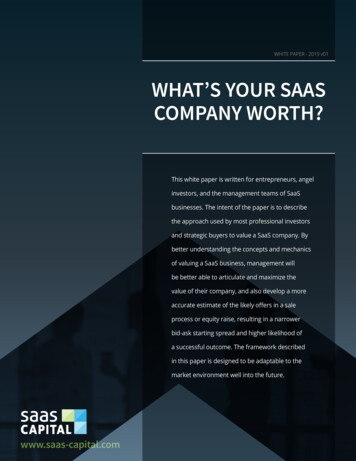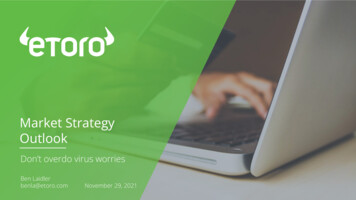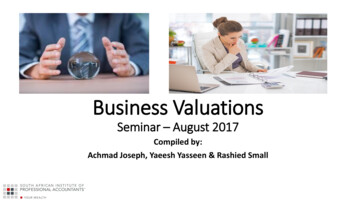
Transcription
Business ValuationsSeminar – August 2017Compiled by:Achmad Joseph, Yaeesh Yasseen & Rashied Small
Business Valuation - ConceptValuation is the process of determining the“economic worth” of an asset or companyunder certain assumptions and limitingconditions and subject to the data available atthe valuation date.[International Valuation Standard Council]Business valuation is a process and a set ofprocedures used to estimate the economicvalue of an owner's interest in a business.Valuation is used by financial marketparticipants to determine the price they arewilling to pay or receive to affect a sale of abusiness.Business Valuation - August 20172
Business Valuation - nceBusinessvaluedriversAsset typesFinancialexpectedreturnCash flowsBusiness Valuation - August 20173
Business Valuation ProcessBusiness Valuation - August 20174
Business Valuation ProcessBusiness Valuation - August 20175
Business Valuation – Risk & ReturnA direct correlation exists between risk and return– the greater the risk the greater is the potentialreturn. However, investments with the highestreturns often bears the greatest risk which can leadto financial ruins.The risk an investor is willing to accept to maximizereturns will depend on his/her risk appetite andrisk tolerance levels.Business Valuation - August 20176
Business Valuation – Risk & ReturnBusiness Valuation - August 20177
Business Valuation – Risk & ReturnBusiness Valuation - August 20178
Business Valuation – Risk & ReturnBusiness Valuation - August 20179
Business Valuation – Measuring ReturnBusiness Valuation - August 201710
Business Valuation – Measuring ReturnsAssumption of CAPM All investors aim to maximise economic returns All investors make decisions based on risks andreturns Investors are rational and risk-averse Investors cannot influence prices – price takers All investors have the same expectations towardsinput factors for investment decisions All investors has access to unlimited funds All investments as liquid and be sold at marketprices No or insignificant transaction costsBusiness Valuation - August 201711
Business Valuation – Measuring ReturnsWeighted Average Cost of CapitalMeasure the average cost of capital of thebusiness based on its capital structure – representthe expected return for the businessBusiness Valuation - August 201712
Weighted Average Cost of CapitalWACCMeasure the average cost of capital ofthe business based on its capitalstructureFINANCING DECISIONS13
Weighted Average Cost of CapitalCapitalReturnRatioAfter taxreturnWACCEquity400,00022%67%22%14.7%Debt %0.7%1Total600,000Weighted cost of capital18.1%FINANCING DECISIONS14
Factors affecting Business ValueBusiness Valuation - August 201715
Business Valuation - Risk FactorsExternalInternalInvestment Expectations of theeconomy Existing conditions in theeconomy Expectation of theindustry Existing conditions in theindustry Competitive environment Expectation of thebusiness Financial position /conditions of the business Competitive position ofthe business Nature and size of thebusiness Quality and depth ofmanagement Risk factors of theinvestment Amount invested in thebusiness Expectation in capitalappreciation Expectation in liquidity ofthe investment Level of expectedmanagement burdenBusiness Valuation - August 201716
Business Valuation - Risk FactorsBusiness Valuation - August 201717
Business Valuation - Risk FactorsBusiness Valuation - August 201718
Business Valuation – Industry hain(Porter’s tuteproductsBusiness Valuation - August 201719
Business Valuation – General FactorsBusiness Valuation - August 201720
Business Valuation – MethodsBusiness Valuation - August 201721
Business Valuation – MethodsBusiness Valuation - August 201722
Business Valuation – Asset-Based MethodsBook Value MethodMethod represents the book value of the business (assets –liabilities) based on their market values – going concernLiquidation Value MethodMethod represents the book value of the business based on theliquidation values – disposal valuesReplacement Value MethodMethod represents the book value of the business based on thereplacement values of the assets – start-up businessBusiness Valuation - August 201723
Business Valuation – Asset-Based MethodsThe following information is the summaries statement of financial position:Book valueNon-current assetsMarket value240 000320 00090 00050 000Inventory180 000160 000Other assets370 000370 000Equity320 000Non-current liabilities250 000250 000Current liabilities310000370 000Intangible assetsBusiness Valuation - August 201724
Business Valuation – Asset-Based MethodsThe following information is the summaries statement of financial position:Book valueNon-current assetsMarket value240 000320 00090 00050 000Inventory180 000160 000Other assets370 000370 000Equity320 000Non-current liabilities250 000250 000Current liabilities310000370 000Net asset value320 000380 000Intangible assetsThe book value of the business is R 320,000 (minimum going concern value) will the net assetvalue (market value of business) is R 380,000 – estimated selling value.Business Valuation - August 201725
Business Valuation – Net Asset Value MethodAdvantagesDisadvantagesAsset AccumulationMethod is very usefulwhen allocating thepurchase price among theindividual business assets.Value of individual assetsmay vary significantlydepending the basis usedvalue the assetsUseful to value asset-based May be difficult in valuingor property investmentindividual assets as thecompaniesassets may interdependentMethod ignores “offbalance sheet” asset andliabilitiesBusiness Valuation - August 201726
Business Valuation – Net Asset Value MethodOff-balance sheetAssetsLiabilities Intellectual propertyitems, such as internallydeveloped products andservices. Key distribution andcustomer contracts. Strategic partnershipagreements. Pending legal judgments. Property and income taxobligations. Environmental compliancecosts.Business Valuation - August 201727
Business Valuation – Asset-Based MethodsThe following information is the summaries statement of financial position:3;1oqBook valueMarket valueNon-current assets640 000 Property will a carrying amount of R 120,000 generatesrental income of R 30,000 per annum and the fair return isconsidered to be 11%.Current assets570 000 Market value of current assets is estimated to be R 550,000Non-current liabilities300 000 The loan is repayable in 5 years and bears interest at a rateof 10%. The market interest rate is 12%.Current liabilities390 000 Market value of the current liabilities amount to R 430,000Business Valuation - August 201728
Business Valuation – Intangible AssetsValuation of Intangible AssetsIntangible assets can be valued using thefollowing methods: Market value: based on market prices forsimilar transaction concluded recently Capitalised income: used for intangibleassets that generate cash or income –capitalised at fair return or discountedcash flow Cost based: estimation of the cost toreproduce the intangible assetBusiness Valuation - August 201729
Forecasting - MethodsBusiness Valuation - August 201730
Forecasting - MethodsBusiness Valuation - August 201731
Forecasting - MethodsBusiness Valuation - August 201732
Business Valuation – Capitalised EarningsFactors to consider when estimating earnings: Business modelMarket positionCompetitive advantageProduct positionCost structureStrength of managementOperating strength/weaknessLocation and accessibilityCustomer baseAsset baseBarriers to entrySupply chainBusiness Valuation - August 201733
Business Valuation – Capitalised EarningsThe following information related to two unrelated businesses:Company A: fair earnings yield is 0,000Company B: fair earnings yield is 13%20X7Earnings230,00020X8290,000Business Valuation - August 201720X9 & after350,00034
Business Valuation – Capitalised EarningsThe following information related to two unrelated businesses:Company A: fair earnings yield is 0,000The value at the end of 20X7: based on the historical trend in profits which indicates an increasingtrend, the estimated future earnings is deemed to be a minimum of R 630,000. Value of thebusiness based on the capitalisation of earnings amounts to R 4,300,000 [630,000/15%].Company B: fair earnings yield is 13%20X7Earnings230,00020X8290,000Business Valuation - August 201720X9 & after350,00035
Business Valuation – Super Profits MethodSupper Profits methodThe supper profits method is used to reflectthe value of the goodwill associated with thebusiness.The supper profits represents the additionalprofit the business generates over itscompetitors in the market. The value of theprofits capitalised for a specified period(usually a maximum of 5 years) representsthe value of goodwill.Business Valuation - August 201736
Business Valuation – Capitalised EarningsThe following information related to two unrelated businesses:Company B: fair earnings yield is 13%20X720X820X9 & afterEarnings230,000290,000350,000Discounted value203,540227,1132,108,4722,539,125The earnings represents the forecasted earnings, therefore the value of the business should bebased on the discounted value. The value of the business is estimated at R 2,539,125 based onthe discounted earnings.Business Valuation - August 201737
Business Valuation – Super Profits MethodThe estimated future profit of the business amounts to R 500,000 while the expected earningsyield is considered to be 18%. The average profit for the industry is considered to be R 400,000.The maintainable earnings of the company is considered to be the average earnings for theindustry and therefore the company generates super profits of R 100,000. Without any barriers toentry the company will not be able to maintain its competitive advantage indefinitely.Capitalised earnings [400,000/18%]2,222,222Super profits – goodwill [100,000 @ 18% for 5 years]Business value312,7172,534,939Business Valuation - August 201738
Business Valuation – Capitalised DividendsDividend Valuation Methods Dividends represent a distribution of profitsin cash or equivalents – cash flow toshareholders Methods that can be used: Dividend capitalisation Discounted cash flow Gordon Growth ModelBusiness Valuation - August 201739
Business Valuation – Capitalised DividendsDividend CapitalisationCapitalised futuredividend at expectedreturnGordon GrowthModelDiscounted Cash FlowCapitalise the futuredividends at theexpected returninclusive of growthPresent value of futuredividends discounted atexpected returnBusiness Valuation - August 201740
Business Valuation – Gordon Growth ModelGordon Growth ModelValue of the business is based on capitalisation offuture dividend incorporating the estimatedgrowth in dividend distribution.The following a key assumptions: Business is stable – no significant change in itsbusiness model and operations Constant growth – the dividends distributedwill growth constantly Stable financial leverage – capital structure willnot change significantly to affect the expectedreturns of equity holders Sufficient cash flow – cash flow of the businesswill be sufficient to maintain its dividendspolicyBusiness Valuation - August 201741
Business Valuation – Free Cash Flow MethodBusiness Valuation - August 201742
Business Valuation – Free Cash Flow MethodBusiness Valuation - August 201743
Business Valuation - August 201744
Business Valuation - August 201745
Business Valuation -Measuring Returns Business Valuation - August 2017 11 Assumption of CAPM All investors aim to maximise economic returns All investors make decisions based on risks and returns Investors are rational and risk-averse Investors cannot influence prices -price takers All investors have the same expectations towards input factors for investment decisions
